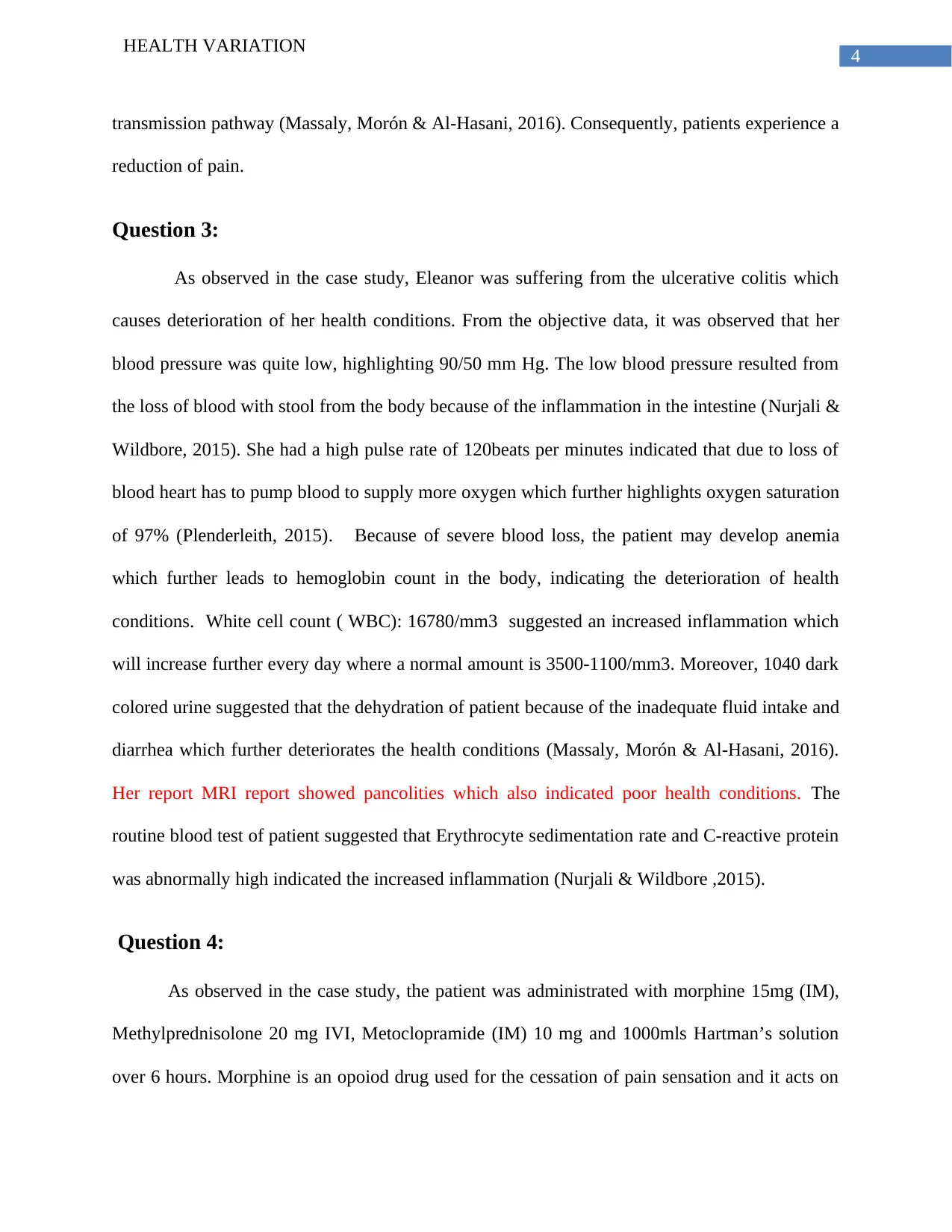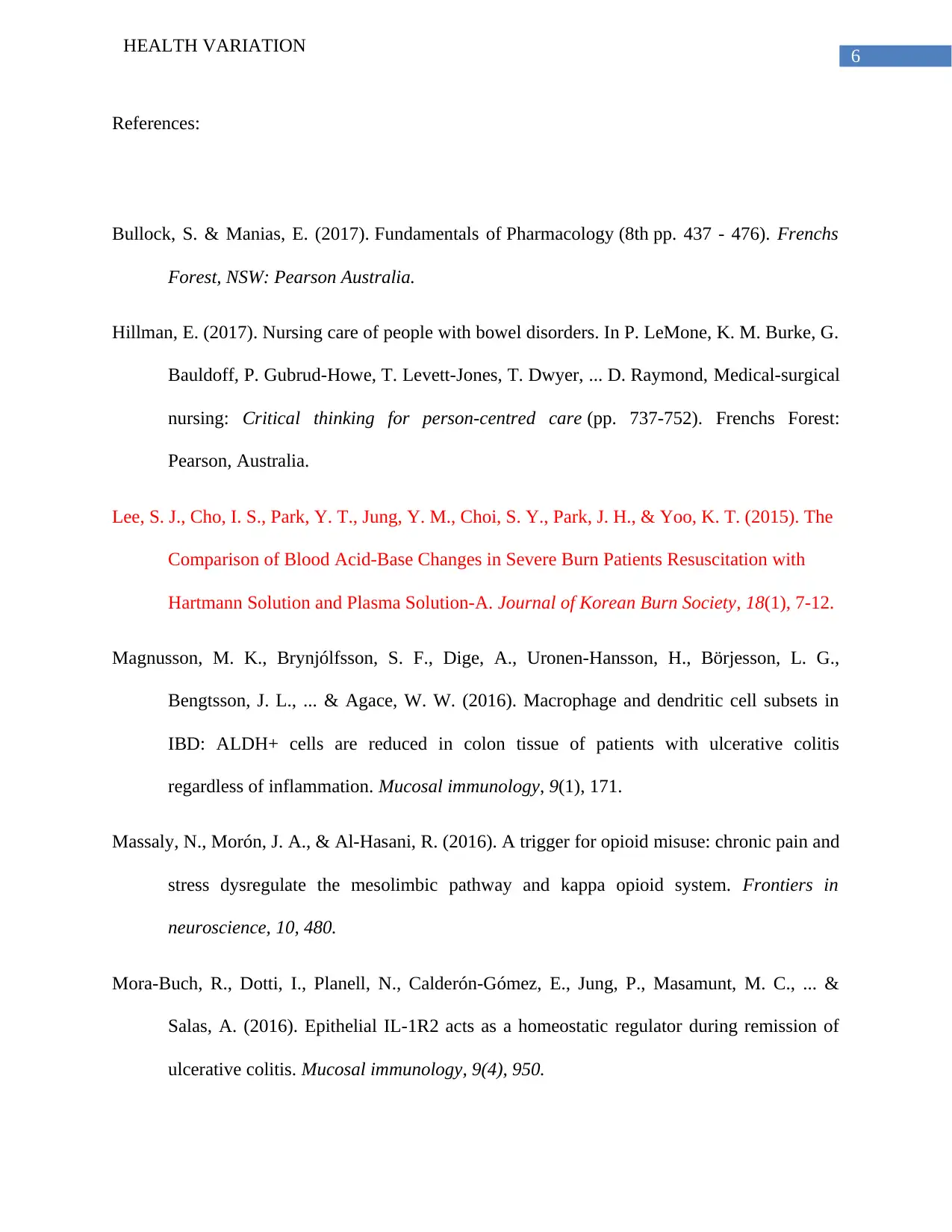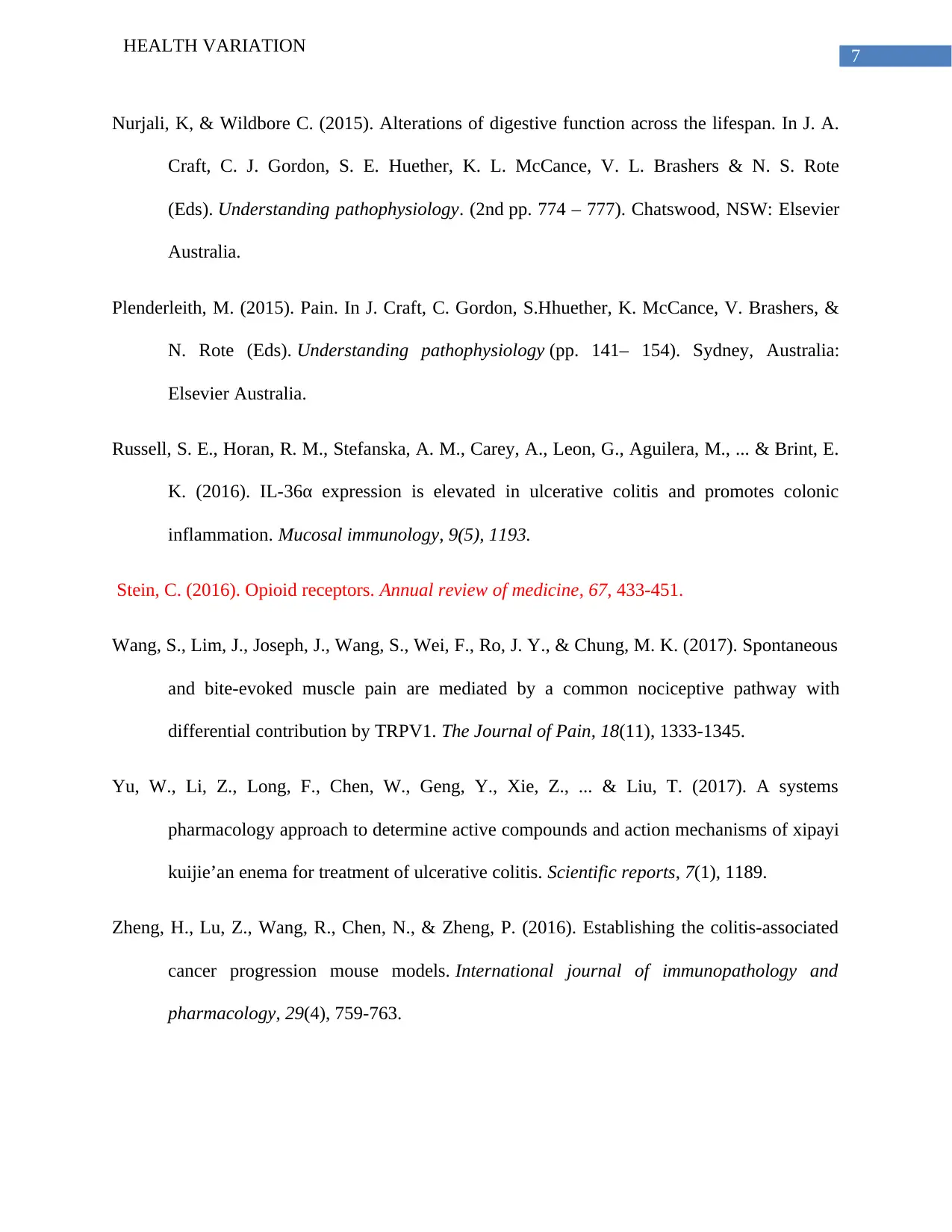Case Study: Management of Ulcerative Colitis with Interventions
VerifiedAdded on 2023/04/11
|7
|1524
|109
Case Study
AI Summary
This case study presents the case of Eleanor Brown, a 48-year-old woman with a long history of ulcerative colitis. She is experiencing an acute exacerbation characterized by frequent bloody diarrhea, severe abdominal pain, and weight loss. The analysis delves into the pathophysiology of ulcerative colitis, explaining how inflammation disrupts the gastrointestinal tract, leading to appetite loss and other symptoms. It discusses the role of inflammatory cytokines and the destruction of the mucosal barrier. The case study also explores the pharmacological interventions used to manage Eleanor's condition, including morphine for pain relief and Hartman's solution to address dehydration and electrolyte imbalance. Furthermore, it examines the significance of objective data, such as blood pressure, pulse rate, and blood test results, in assessing the severity of the condition and guiding treatment decisions. This assignment highlights the complexities of managing ulcerative colitis and the importance of a comprehensive approach to care.

Running head : HEALTH VARIATION
Name of the Student
Name of the University ‘
Author Note
Name of the Student
Name of the University ‘
Author Note
Paraphrase This Document
Need a fresh take? Get an instant paraphrase of this document with our AI Paraphraser

2
HEALTH VARIATION
Question 1:
The case study represents ulcerative colitis of a 48 years old lady, Eleanor Brown who
was suffering from the severe ulcerative colitis since the age of 31. The case study suggested that
from the last two weeks she was experiencing exacerbation and she was feeling fatigue along
with diarrhea secreting pus, blood. In the last two week, she lost her 9kg of weight and feeling
too ill to eat. Moreover, she complained that the she was unable to perform her daily activities.
From the case study, it was observed that the weight loss of the patient is clearly due to the loss
of appetite as a result of ulcerative colitis. As discussed by Plenderleith, (2015), ulcerative
colitis is an autoimmune disease which usually begins in the rectum and either it remains
localized or extended proximally. The structural and functional changes of the gastrointestinal
tract led to the appetite loss. GI tract of the human body is guarded by the mucous layer which
provides a physical layer in between commensals and host-microbial cells. The disruption of the
tight junction of the cell layers give rise to the inflammation observed in the case study. The
disruption facilitates the permeability of the epithelial layers and microbes can reach to the
epithelial cell of intestine triggers the uptake of luminal antigens and induction of NF-kB (Mora-
Buch et al., 2016). The induction of this pathway induces the production of the proinflammatory
cytokines (interleukins) and TNF-α. The activation of these cytokines induces the CD4 T cell-
mediated production of IL4 and IL3 (Russell et al., 2016). According to Magnusson et al.
(2016) IL3 is associated with the destruction of epithelial barrier which further recruited more
immune cells and crypt abscess along with pseudo polyps developed which is an indication of
the ulcerative colitis. The intestine shows multiple ulceration, especially sub mucosa shows
intense inflammation. These structural changes in the intestine facilitate the acids of the GI tract
to interact with the epithelial cells. The destruction of the mucosal barriers induces efflux of H+
HEALTH VARIATION
Question 1:
The case study represents ulcerative colitis of a 48 years old lady, Eleanor Brown who
was suffering from the severe ulcerative colitis since the age of 31. The case study suggested that
from the last two weeks she was experiencing exacerbation and she was feeling fatigue along
with diarrhea secreting pus, blood. In the last two week, she lost her 9kg of weight and feeling
too ill to eat. Moreover, she complained that the she was unable to perform her daily activities.
From the case study, it was observed that the weight loss of the patient is clearly due to the loss
of appetite as a result of ulcerative colitis. As discussed by Plenderleith, (2015), ulcerative
colitis is an autoimmune disease which usually begins in the rectum and either it remains
localized or extended proximally. The structural and functional changes of the gastrointestinal
tract led to the appetite loss. GI tract of the human body is guarded by the mucous layer which
provides a physical layer in between commensals and host-microbial cells. The disruption of the
tight junction of the cell layers give rise to the inflammation observed in the case study. The
disruption facilitates the permeability of the epithelial layers and microbes can reach to the
epithelial cell of intestine triggers the uptake of luminal antigens and induction of NF-kB (Mora-
Buch et al., 2016). The induction of this pathway induces the production of the proinflammatory
cytokines (interleukins) and TNF-α. The activation of these cytokines induces the CD4 T cell-
mediated production of IL4 and IL3 (Russell et al., 2016). According to Magnusson et al.
(2016) IL3 is associated with the destruction of epithelial barrier which further recruited more
immune cells and crypt abscess along with pseudo polyps developed which is an indication of
the ulcerative colitis. The intestine shows multiple ulceration, especially sub mucosa shows
intense inflammation. These structural changes in the intestine facilitate the acids of the GI tract
to interact with the epithelial cells. The destruction of the mucosal barriers induces efflux of H+

3
HEALTH VARIATION
ion which causes watery diarrhea with blood and pus (Mora-Buch et al., 2016). Because of the
inflammation patient loss of appetite and since normal mucosa absorbs food, patients with
inflammation failed to absorb intake food which led to the weight loss as observed in this case
study.
Question 2:
As observed in this case study, Eleanor Brown was suffering from pain due to ulcerative
colitis. As discussed by Hillman (2017), pain is associated with ulcerative colitis where visceral
pain is associated with the inflammatory responses of the GI tract. The inflammation induces the
activation of sensory neurons (nocireceptor) and indirectly responded to the chemical released by
damaged tissue. These nerve endings have transient receptor potential which turns into transduce
a variety of noxious stimuli into receptor potential which initiate action potentials. The potential
then transmitted to spinal cord by ascending pathway called spinothalamic tract from which the
signal transmitted to the brain stem (thalamocortical) which conveys the information to the
cerebral cortex where sensation of pain can register. Cerebral cortex prompts the action to reduce
the pain. In the current context, Eleonor was prescribed with the morphine for reduction of the
sensation of pain. As discussed by Hillman (2017), Morphine is a drug of the opiate family
which is frequently used in the ulcerative colitis to reduce the sensation of pain in the patient.
Morphine attached to four major receptors such as delta, kappa, mu and nocireceptor and
induced hyperpolarization of the inflamed cells and reduction of the presynaptic neurotransmitter
released due to pain sensation (Stein, 2016).Morphine also facilitates the cessation of the calcium
ion and reduces the release of the neurotransmitters from the nerve endings located in the pain
HEALTH VARIATION
ion which causes watery diarrhea with blood and pus (Mora-Buch et al., 2016). Because of the
inflammation patient loss of appetite and since normal mucosa absorbs food, patients with
inflammation failed to absorb intake food which led to the weight loss as observed in this case
study.
Question 2:
As observed in this case study, Eleanor Brown was suffering from pain due to ulcerative
colitis. As discussed by Hillman (2017), pain is associated with ulcerative colitis where visceral
pain is associated with the inflammatory responses of the GI tract. The inflammation induces the
activation of sensory neurons (nocireceptor) and indirectly responded to the chemical released by
damaged tissue. These nerve endings have transient receptor potential which turns into transduce
a variety of noxious stimuli into receptor potential which initiate action potentials. The potential
then transmitted to spinal cord by ascending pathway called spinothalamic tract from which the
signal transmitted to the brain stem (thalamocortical) which conveys the information to the
cerebral cortex where sensation of pain can register. Cerebral cortex prompts the action to reduce
the pain. In the current context, Eleonor was prescribed with the morphine for reduction of the
sensation of pain. As discussed by Hillman (2017), Morphine is a drug of the opiate family
which is frequently used in the ulcerative colitis to reduce the sensation of pain in the patient.
Morphine attached to four major receptors such as delta, kappa, mu and nocireceptor and
induced hyperpolarization of the inflamed cells and reduction of the presynaptic neurotransmitter
released due to pain sensation (Stein, 2016).Morphine also facilitates the cessation of the calcium
ion and reduces the release of the neurotransmitters from the nerve endings located in the pain
⊘ This is a preview!⊘
Do you want full access?
Subscribe today to unlock all pages.

Trusted by 1+ million students worldwide

4
HEALTH VARIATION
transmission pathway (Massaly, Morón & Al-Hasani, 2016). Consequently, patients experience a
reduction of pain.
Question 3:
As observed in the case study, Eleanor was suffering from the ulcerative colitis which
causes deterioration of her health conditions. From the objective data, it was observed that her
blood pressure was quite low, highlighting 90/50 mm Hg. The low blood pressure resulted from
the loss of blood with stool from the body because of the inflammation in the intestine (Nurjali &
Wildbore, 2015). She had a high pulse rate of 120beats per minutes indicated that due to loss of
blood heart has to pump blood to supply more oxygen which further highlights oxygen saturation
of 97% (Plenderleith, 2015). Because of severe blood loss, the patient may develop anemia
which further leads to hemoglobin count in the body, indicating the deterioration of health
conditions. White cell count ( WBC): 16780/mm3 suggested an increased inflammation which
will increase further every day where a normal amount is 3500-1100/mm3. Moreover, 1040 dark
colored urine suggested that the dehydration of patient because of the inadequate fluid intake and
diarrhea which further deteriorates the health conditions (Massaly, Morón & Al-Hasani, 2016).
Her report MRI report showed pancolities which also indicated poor health conditions. The
routine blood test of patient suggested that Erythrocyte sedimentation rate and C-reactive protein
was abnormally high indicated the increased inflammation (Nurjali & Wildbore ,2015).
Question 4:
As observed in the case study, the patient was administrated with morphine 15mg (IM),
Methylprednisolone 20 mg IVI, Metoclopramide (IM) 10 mg and 1000mls Hartman’s solution
over 6 hours. Morphine is an opoiod drug used for the cessation of pain sensation and it acts on
HEALTH VARIATION
transmission pathway (Massaly, Morón & Al-Hasani, 2016). Consequently, patients experience a
reduction of pain.
Question 3:
As observed in the case study, Eleanor was suffering from the ulcerative colitis which
causes deterioration of her health conditions. From the objective data, it was observed that her
blood pressure was quite low, highlighting 90/50 mm Hg. The low blood pressure resulted from
the loss of blood with stool from the body because of the inflammation in the intestine (Nurjali &
Wildbore, 2015). She had a high pulse rate of 120beats per minutes indicated that due to loss of
blood heart has to pump blood to supply more oxygen which further highlights oxygen saturation
of 97% (Plenderleith, 2015). Because of severe blood loss, the patient may develop anemia
which further leads to hemoglobin count in the body, indicating the deterioration of health
conditions. White cell count ( WBC): 16780/mm3 suggested an increased inflammation which
will increase further every day where a normal amount is 3500-1100/mm3. Moreover, 1040 dark
colored urine suggested that the dehydration of patient because of the inadequate fluid intake and
diarrhea which further deteriorates the health conditions (Massaly, Morón & Al-Hasani, 2016).
Her report MRI report showed pancolities which also indicated poor health conditions. The
routine blood test of patient suggested that Erythrocyte sedimentation rate and C-reactive protein
was abnormally high indicated the increased inflammation (Nurjali & Wildbore ,2015).
Question 4:
As observed in the case study, the patient was administrated with morphine 15mg (IM),
Methylprednisolone 20 mg IVI, Metoclopramide (IM) 10 mg and 1000mls Hartman’s solution
over 6 hours. Morphine is an opoiod drug used for the cessation of pain sensation and it acts on
Paraphrase This Document
Need a fresh take? Get an instant paraphrase of this document with our AI Paraphraser

5
HEALTH VARIATION
G-protein coupled receptors. In the current context, Hartman’s solution was administrated
intravenously to avoid the first pass effect of the liver where the drugs directly absorbed by the
blood without eliminating the maximum portion of it (Yu et al., 2017). Hartman’s solution is
colorless and sterile solution which is used in treatment of extracellular dehydration because of
water loss because of bloody diarrhea which was patient experiencing. The solution
encompasses sodium chloride, potassium chloride, calcium chloride dihydrate and sodium
lactates. The Hartman’s solution was prescribed for restoring the as the calcium and sodium of
the body. Although it is hypotonic nature but it also provides anions which are close proximate
to the plasma pH and replace the electrolytes which were lost during the diarrhea. The solution
also used to treat the metabolic acidosis which was observed due to the acid base imbalance in
patient (Lee et al., 2015).
HEALTH VARIATION
G-protein coupled receptors. In the current context, Hartman’s solution was administrated
intravenously to avoid the first pass effect of the liver where the drugs directly absorbed by the
blood without eliminating the maximum portion of it (Yu et al., 2017). Hartman’s solution is
colorless and sterile solution which is used in treatment of extracellular dehydration because of
water loss because of bloody diarrhea which was patient experiencing. The solution
encompasses sodium chloride, potassium chloride, calcium chloride dihydrate and sodium
lactates. The Hartman’s solution was prescribed for restoring the as the calcium and sodium of
the body. Although it is hypotonic nature but it also provides anions which are close proximate
to the plasma pH and replace the electrolytes which were lost during the diarrhea. The solution
also used to treat the metabolic acidosis which was observed due to the acid base imbalance in
patient (Lee et al., 2015).

6
HEALTH VARIATION
References:
Bullock, S. & Manias, E. (2017). Fundamentals of Pharmacology (8th pp. 437 - 476). Frenchs
Forest, NSW: Pearson Australia.
Hillman, E. (2017). Nursing care of people with bowel disorders. In P. LeMone, K. M. Burke, G.
Bauldoff, P. Gubrud-Howe, T. Levett-Jones, T. Dwyer, ... D. Raymond, Medical-surgical
nursing: Critical thinking for person-centred care (pp. 737-752). Frenchs Forest:
Pearson, Australia.
Lee, S. J., Cho, I. S., Park, Y. T., Jung, Y. M., Choi, S. Y., Park, J. H., & Yoo, K. T. (2015). The
Comparison of Blood Acid-Base Changes in Severe Burn Patients Resuscitation with
Hartmann Solution and Plasma Solution-A. Journal of Korean Burn Society, 18(1), 7-12.
Magnusson, M. K., Brynjólfsson, S. F., Dige, A., Uronen-Hansson, H., Börjesson, L. G.,
Bengtsson, J. L., ... & Agace, W. W. (2016). Macrophage and dendritic cell subsets in
IBD: ALDH+ cells are reduced in colon tissue of patients with ulcerative colitis
regardless of inflammation. Mucosal immunology, 9(1), 171.
Massaly, N., Morón, J. A., & Al-Hasani, R. (2016). A trigger for opioid misuse: chronic pain and
stress dysregulate the mesolimbic pathway and kappa opioid system. Frontiers in
neuroscience, 10, 480.
Mora-Buch, R., Dotti, I., Planell, N., Calderón-Gómez, E., Jung, P., Masamunt, M. C., ... &
Salas, A. (2016). Epithelial IL-1R2 acts as a homeostatic regulator during remission of
ulcerative colitis. Mucosal immunology, 9(4), 950.
HEALTH VARIATION
References:
Bullock, S. & Manias, E. (2017). Fundamentals of Pharmacology (8th pp. 437 - 476). Frenchs
Forest, NSW: Pearson Australia.
Hillman, E. (2017). Nursing care of people with bowel disorders. In P. LeMone, K. M. Burke, G.
Bauldoff, P. Gubrud-Howe, T. Levett-Jones, T. Dwyer, ... D. Raymond, Medical-surgical
nursing: Critical thinking for person-centred care (pp. 737-752). Frenchs Forest:
Pearson, Australia.
Lee, S. J., Cho, I. S., Park, Y. T., Jung, Y. M., Choi, S. Y., Park, J. H., & Yoo, K. T. (2015). The
Comparison of Blood Acid-Base Changes in Severe Burn Patients Resuscitation with
Hartmann Solution and Plasma Solution-A. Journal of Korean Burn Society, 18(1), 7-12.
Magnusson, M. K., Brynjólfsson, S. F., Dige, A., Uronen-Hansson, H., Börjesson, L. G.,
Bengtsson, J. L., ... & Agace, W. W. (2016). Macrophage and dendritic cell subsets in
IBD: ALDH+ cells are reduced in colon tissue of patients with ulcerative colitis
regardless of inflammation. Mucosal immunology, 9(1), 171.
Massaly, N., Morón, J. A., & Al-Hasani, R. (2016). A trigger for opioid misuse: chronic pain and
stress dysregulate the mesolimbic pathway and kappa opioid system. Frontiers in
neuroscience, 10, 480.
Mora-Buch, R., Dotti, I., Planell, N., Calderón-Gómez, E., Jung, P., Masamunt, M. C., ... &
Salas, A. (2016). Epithelial IL-1R2 acts as a homeostatic regulator during remission of
ulcerative colitis. Mucosal immunology, 9(4), 950.
⊘ This is a preview!⊘
Do you want full access?
Subscribe today to unlock all pages.

Trusted by 1+ million students worldwide

7
HEALTH VARIATION
Nurjali, K, & Wildbore C. (2015). Alterations of digestive function across the lifespan. In J. A.
Craft, C. J. Gordon, S. E. Huether, K. L. McCance, V. L. Brashers & N. S. Rote
(Eds). Understanding pathophysiology. (2nd pp. 774 – 777). Chatswood, NSW: Elsevier
Australia.
Plenderleith, M. (2015). Pain. In J. Craft, C. Gordon, S.Hhuether, K. McCance, V. Brashers, &
N. Rote (Eds). Understanding pathophysiology (pp. 141– 154). Sydney, Australia:
Elsevier Australia.
Russell, S. E., Horan, R. M., Stefanska, A. M., Carey, A., Leon, G., Aguilera, M., ... & Brint, E.
K. (2016). IL-36α expression is elevated in ulcerative colitis and promotes colonic
inflammation. Mucosal immunology, 9(5), 1193.
Stein, C. (2016). Opioid receptors. Annual review of medicine, 67, 433-451.
Wang, S., Lim, J., Joseph, J., Wang, S., Wei, F., Ro, J. Y., & Chung, M. K. (2017). Spontaneous
and bite-evoked muscle pain are mediated by a common nociceptive pathway with
differential contribution by TRPV1. The Journal of Pain, 18(11), 1333-1345.
Yu, W., Li, Z., Long, F., Chen, W., Geng, Y., Xie, Z., ... & Liu, T. (2017). A systems
pharmacology approach to determine active compounds and action mechanisms of xipayi
kuijie’an enema for treatment of ulcerative colitis. Scientific reports, 7(1), 1189.
Zheng, H., Lu, Z., Wang, R., Chen, N., & Zheng, P. (2016). Establishing the colitis-associated
cancer progression mouse models. International journal of immunopathology and
pharmacology, 29(4), 759-763.
HEALTH VARIATION
Nurjali, K, & Wildbore C. (2015). Alterations of digestive function across the lifespan. In J. A.
Craft, C. J. Gordon, S. E. Huether, K. L. McCance, V. L. Brashers & N. S. Rote
(Eds). Understanding pathophysiology. (2nd pp. 774 – 777). Chatswood, NSW: Elsevier
Australia.
Plenderleith, M. (2015). Pain. In J. Craft, C. Gordon, S.Hhuether, K. McCance, V. Brashers, &
N. Rote (Eds). Understanding pathophysiology (pp. 141– 154). Sydney, Australia:
Elsevier Australia.
Russell, S. E., Horan, R. M., Stefanska, A. M., Carey, A., Leon, G., Aguilera, M., ... & Brint, E.
K. (2016). IL-36α expression is elevated in ulcerative colitis and promotes colonic
inflammation. Mucosal immunology, 9(5), 1193.
Stein, C. (2016). Opioid receptors. Annual review of medicine, 67, 433-451.
Wang, S., Lim, J., Joseph, J., Wang, S., Wei, F., Ro, J. Y., & Chung, M. K. (2017). Spontaneous
and bite-evoked muscle pain are mediated by a common nociceptive pathway with
differential contribution by TRPV1. The Journal of Pain, 18(11), 1333-1345.
Yu, W., Li, Z., Long, F., Chen, W., Geng, Y., Xie, Z., ... & Liu, T. (2017). A systems
pharmacology approach to determine active compounds and action mechanisms of xipayi
kuijie’an enema for treatment of ulcerative colitis. Scientific reports, 7(1), 1189.
Zheng, H., Lu, Z., Wang, R., Chen, N., & Zheng, P. (2016). Establishing the colitis-associated
cancer progression mouse models. International journal of immunopathology and
pharmacology, 29(4), 759-763.
1 out of 7
Related Documents
Your All-in-One AI-Powered Toolkit for Academic Success.
+13062052269
info@desklib.com
Available 24*7 on WhatsApp / Email
![[object Object]](/_next/static/media/star-bottom.7253800d.svg)
Unlock your academic potential
Copyright © 2020–2025 A2Z Services. All Rights Reserved. Developed and managed by ZUCOL.





